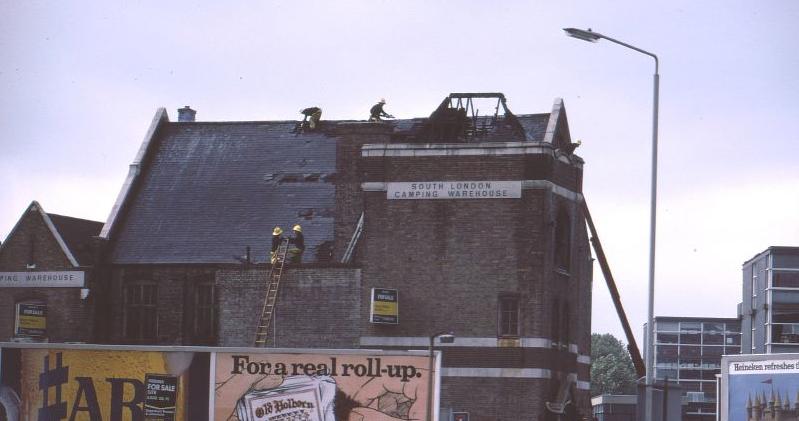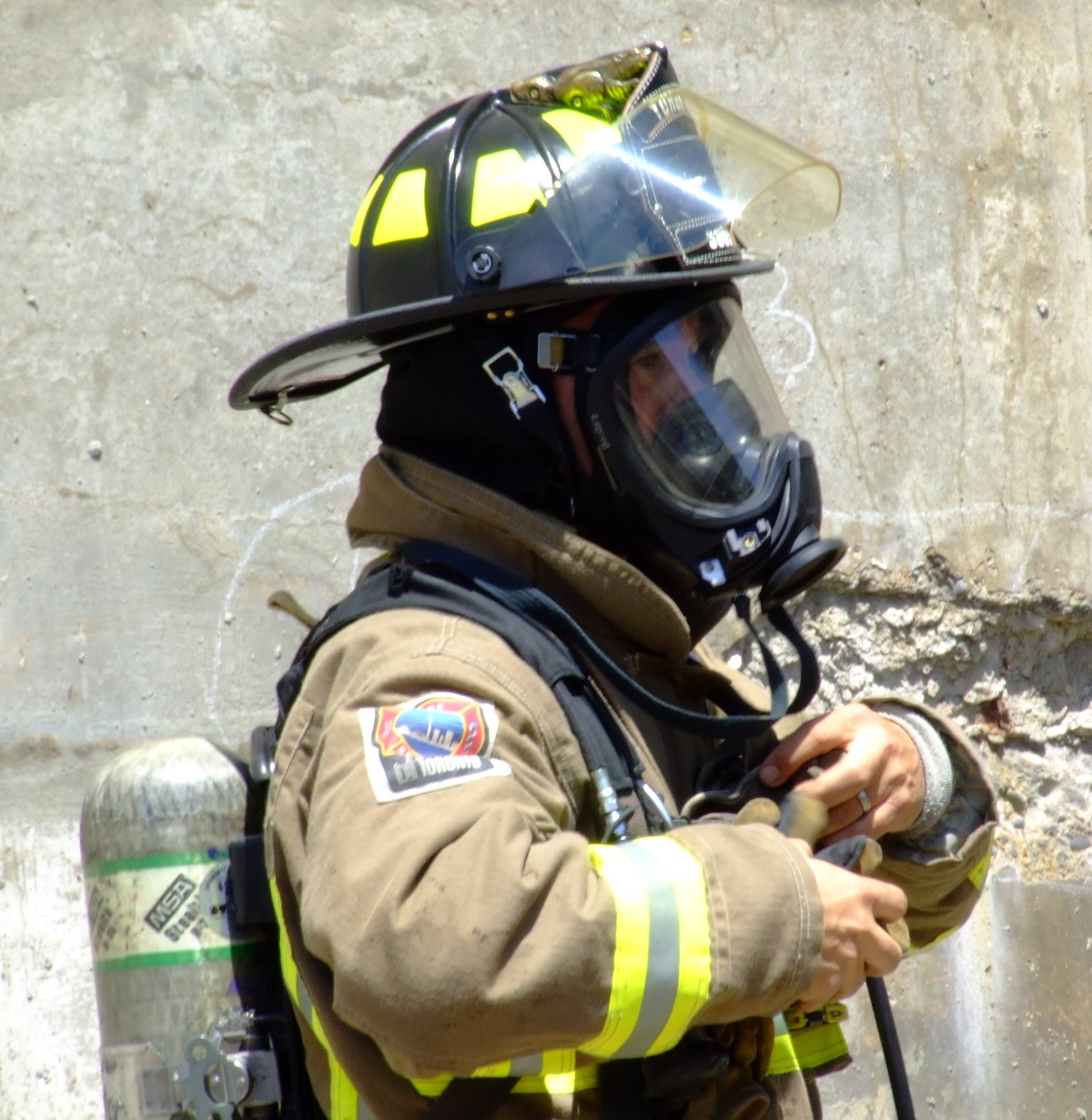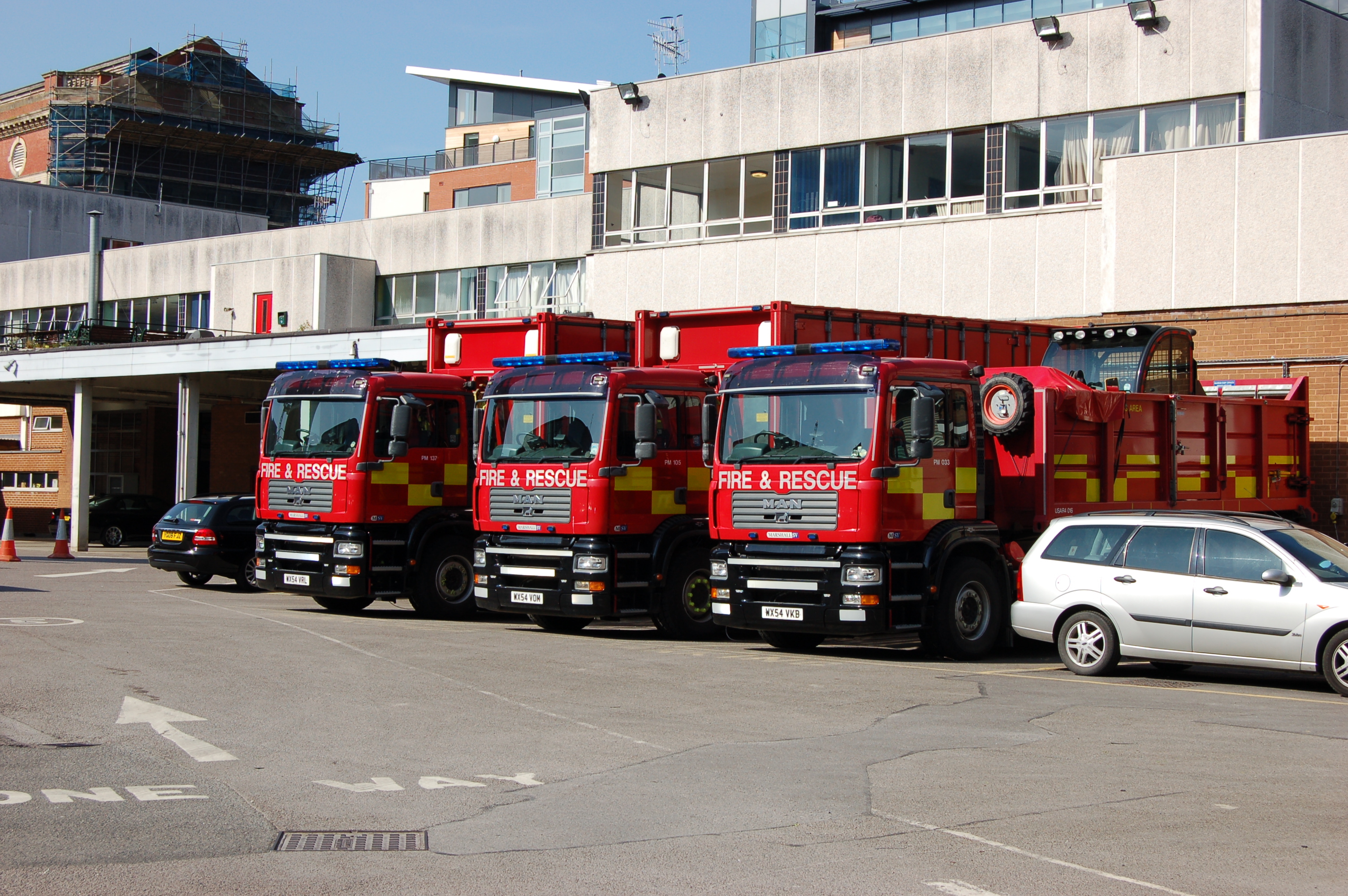|
Fire Appliances Of The United Kingdom
Fire services in the United Kingdom use a variety of fire appliances, which perform a wide range of general and specialised roles and fit into several distinct categories. Contemporary fire appliances carry a multitude of equipment and firefighting media (such as water and foam) to deal with different types of emergencies ranging from fires, rescues, vehicle extrication, floods, salvage, casualty and trauma care. The design and size of a fire appliance depends very much upon the role it is expected to perform. In general, most fire and rescue services use a standardised range of vehicles and equipment. However, airport fire services tend to use much larger and heavier appliances than those typically deployed by public fire services. Most front line fire appliances in the UK are marked in high conspicuity red and yellow battenburg markings, and are fitted with blue lights and sirens. Many appliances have roller shutter doors revealing compartments housing various items of equi ... [...More Info...] [...Related Items...] OR: [Wikipedia] [Google] [Baidu] |
LFB Pump Ladder
The London Fire Brigade (LFB) is the fire and rescue service for London, the capital of the United Kingdom. It was formed by the Metropolitan Fire Brigade Act 1865, under the leadership of superintendent Eyre Massey Shaw. It has 5,992staff, including 5,096 operational firefighters and officers based at 102 fire stations (plus one river station). The LFB is led by the Commissioner for Fire and Emergency Planning, a position currently held by Andy Roe. The brigade and Commissioner are overseen by the Greater London Authority, which in 2018 took over these responsibilities from the London Fire and Emergency Planning Authority (LFEPA). In the 2015-16 financial year the LFB received 171,488 emergency calls. These consisted of: 20,773 fires, 48,696 false alarms of fire and 30,066 other calls for service. As well as firefighting, the LFB also responds to road traffic collisions, floods, shut-in-lift releases, and other incidents such as those involving hazardous materials or major ... [...More Info...] [...Related Items...] OR: [Wikipedia] [Google] [Baidu] |
SCBA
A self-contained breathing apparatus (SCBA), sometimes referred to as a compressed air breathing apparatus (CABA) or simply breathing apparatus (BA), is a device worn to provide breathable air in an atmosphere that is immediately dangerous to life or health. They are typically used in firefighting and industry. The term ''self-contained'' means that the SCBA is not dependent on a remote supply of breathing gas (e.g., through a long hose). If designed for use under water, it is also known as a Scuba set (self-contained underwater breathing apparatus). When not used underwater, they are sometimes called industrial breathing sets. Unofficial names include ''air pack'', ''air tank'', ''oxygen cylinder'' or simply ''pack'', which are mostly used in firefighting. An SCBA typically has three main components: a high-pressure tank (e.g., , about 150 to 374 atmospheres), a pressure regulator, and an inhalation connection (mouthpiece, mouth mask or face mask), connected together and mount ... [...More Info...] [...Related Items...] OR: [Wikipedia] [Google] [Baidu] |
New Dimension Programme
The New Dimension programme, sometimes referred to as the New Dimension or New Dimensions, was started by the Department for Communities and Local Government in the UK, for fire and rescue services in England and Wales, following the September 11, 2001 attacks in the United States. It has provided equipment, training and standardised procedures to deal with terrorist attacks and major environmental disasters. By July 2004, the New Dimension programme had provided £56 million to various projects; a further £132 million was promised for the period up to 2007. The New Dimension programme operates at a national, regional and local level, and while it does not apply specifically to Scotland, a Fire and Rescue Service circular, published in 2007 noted that: "Officials in the Welsh Assembly Government and the Scottish Executive agree in principle that the general terms of the Mutual Aid Protocol should apply 'cross-border' between Scotland, England (and Wales)." New Dimension provi ... [...More Info...] [...Related Items...] OR: [Wikipedia] [Google] [Baidu] |
Fire Investigation Unit
Fire is the rapid oxidation of a material (the fuel) in the exothermic chemical process of combustion, releasing heat, light, and various reaction products. At a certain point in the combustion reaction, called the ignition point, flames are produced. The ''flame'' is the visible portion of the fire. Flames consist primarily of carbon dioxide, water vapor, oxygen and nitrogen. If hot enough, the gases may become ionized to produce plasma. Depending on the substances alight, and any impurities outside, the color of the flame and the fire's intensity will be different. Fire in its most common form can result in conflagration, which has the potential to cause physical damage through burning. Fire is an important process that affects ecological systems around the globe. The positive effects of fire include stimulating growth and maintaining various ecological systems. Its negative effects include hazard to life and property, atmospheric pollution, and water contamination. If fire r ... [...More Info...] [...Related Items...] OR: [Wikipedia] [Google] [Baidu] |
LFB Scientific Support Unit
The London Fire Brigade (LFB) is the fire and rescue service for London, the capital of the United Kingdom. It was formed by the Metropolitan Fire Brigade Act 1865, under the leadership of superintendent Eyre Massey Shaw. It has 5,992staff, including 5,096 operational firefighters and officers based at 102 fire stations (plus one river station). The LFB is led by the Commissioner for Fire and Emergency Planning, a position currently held by Andy Roe. The brigade and Commissioner are overseen by the Greater London Authority, which in 2018 took over these responsibilities from the London Fire and Emergency Planning Authority (LFEPA). In the 2015-16 financial year the LFB received 171,488 emergency calls. These consisted of: 20,773 fires, 48,696 false alarms of fire and 30,066 other calls for service. As well as firefighting, the LFB also responds to road traffic collisions, floods, shut-in-lift releases, and other incidents such as those involving hazardous materials or major tr ... [...More Info...] [...Related Items...] OR: [Wikipedia] [Google] [Baidu] |
Operational Support Unit (London Fire Brigade, 2007)
An operational definition specifies concrete, replicable procedures designed to represent a construct. In the words of American psychologist S.S. Stevens (1935), "An operation is the performance which we execute in order to make known a concept." For example, an operational definition of "fear" (the construct) often includes measurable physiologic responses that occur in response to a perceived threat. Thus, "fear" might be operationally defined as specified changes in heart rate, galvanic skin response, pupil dilation, and blood pressure. Overview An operational definition is designed to model or represent a concept or theoretical definition, also known as a construct. Scientists should describe the operations (procedures, actions, or processes) that define the concept with enough specificity such that other investigators can replicate their research. Operational definitions are also used to define system states in terms of a specific, publicly accessible process of preparation ... [...More Info...] [...Related Items...] OR: [Wikipedia] [Google] [Baidu] |
Confined Space Rescue
Confined space rescue is a subset of technical rescue operations that involves the rescue and recovery of victims trapped in a confined space or in a place only accessible through confined spaces, such as underground vaults, storage silos, storage tanks, or sewers. Confined spaces are often narrow and constricting, preventing easy access by rescuers, making confined space rescues technically challenging;. The spaces are usually unlit or poorly lit, requiring a light source to be provided. Confined spaces may contain hazardous materials in liquid or gas form, and oxygen may be limited. These hazards can be fatal as they create a limited window of time in which to perform a rescue. After four minutes without oxygen a person will usually suffer asphyxia causing brain damage or death. The urgent need to rescue someone from a confined space often leads to ill-prepared rescue attempts. Two-thirds of all of deaths occurring in confined spaces are attributed to persons attempting to resc ... [...More Info...] [...Related Items...] OR: [Wikipedia] [Google] [Baidu] |
Swiftwater Rescue
Swift water rescue (also called "white water rescue") is a subset of technical rescue dealing in white water river conditions. Due to the added pressure of moving water, swift water rescue involves the use of specially trained personnel, ropes and mechanical advantage systems that are often much more robust than those used in standard rope rescue. The main goal is to use or deflect the water’s power to assist in the rescue of the endangered person(s), as in most situations there is no easy way to overcome the power of the water. Rescue operations As a swift water rescue scene evolves, the Incident Command System (ICS) will emerge. ICS is a national protocol used for managing emergencies in the United States. Initially created by Jim Segerstrom and Michael Croslin co-founders of Rescue 3, Sonora California as a response to all the firefighters who were dying in water rescues], SRT has now been taught to over 200,000 rescue personnel in some 2 dozen countries. ICS has become the b ... [...More Info...] [...Related Items...] OR: [Wikipedia] [Google] [Baidu] |
Essex Fire And Rescue Truck
Essex () is a county in the East of England. One of the home counties, it borders Suffolk and Cambridgeshire to the north, the North Sea to the east, Hertfordshire to the west, Kent across the estuary of the River Thames to the south, and Greater London to the south and south-west. There are three cities in Essex: Southend, Colchester and Chelmsford, in order of population. For the purposes of government statistics, Essex is placed in the East of England region. There are four definitions of the extent of Essex, the widest being the ancient county. Next, the largest is the former postal county, followed by the ceremonial county, with the smallest being the administrative county—the area administered by the County Council, which excludes the two unitary authorities of Thurrock and Southend-on-Sea. The ceremonial county occupies the eastern part of what was, during the Early Middle Ages, the Anglo-Saxon Kingdom of Essex. As well as rural areas and urban areas, it forms part of ... [...More Info...] [...Related Items...] OR: [Wikipedia] [Google] [Baidu] |






